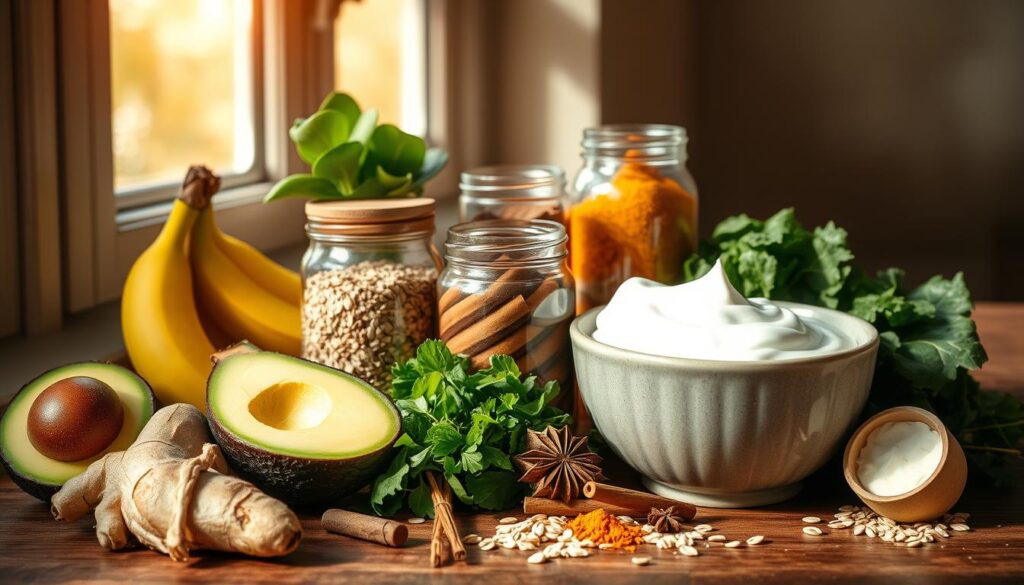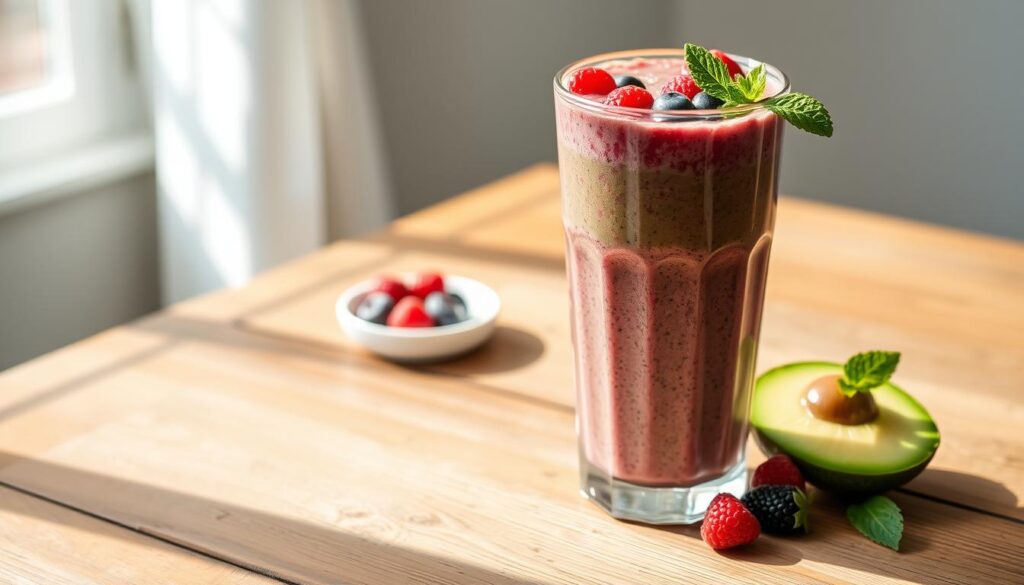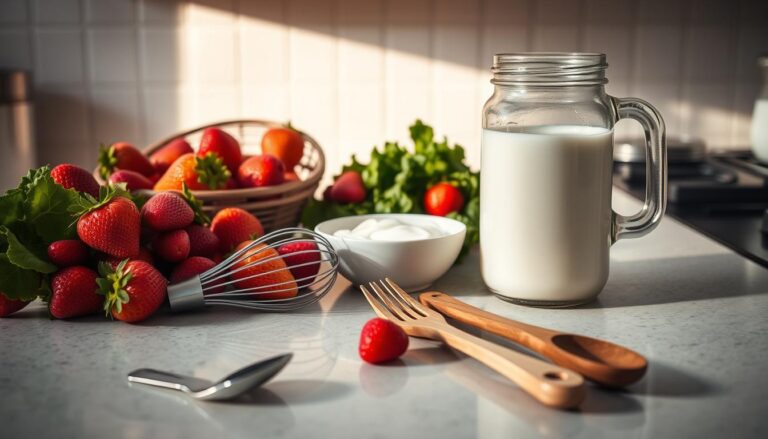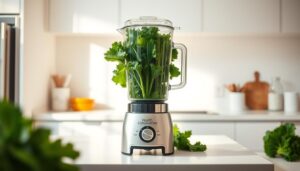Are Smoothies Good for Acid Reflux is the question many vegan people in the United States ask when reflux makes meals risky.
Could a well-made smoothie actually calm your esophagus instead of triggering symptoms? You want clear guidance you can use today.
GERD affects about 20% of people in the U.S., and it happens when stomach contents flow back and irritate the esophagus. Choosing low-acid, fiber-forward blends can help reduce bothersome symptoms after meals.
Focus on oats, bananas, pears, spinach, avocado, nuts, and seeds to add gentle fiber and plant-based fats that do not raise reflux risk. Avoid citrus, tomato, chocolate, caffeine, peppermint, and spicy add-ins.
Blend to a smooth texture, skip excess ice, sip slowly, and stay upright after drinking. These small shifts can ease your stomach and support long-term health while you track what works for your condition.
Table of Contents
Key Takeaways
- Use low-acid, fiber-rich ingredients to soothe reflux and support digestion.
- Avoid known triggers like citrus, tomato, chocolate, and caffeine in blends.
- Blend smooth, limit ice, sip slowly, and stay upright after drinking.
- Test ingredients one at a time to see how your stomach and esophagus respond.
- Try our smoothie generator to craft vegan-friendly recipes: Make a personalized smoothie.
Are Smoothies Good for Acid Reflux? What You Need to Know as a Vegan
If you follow a plant-based diet and live with reflux, blending the right ingredients can calm your esophagus and cut symptom flare-ups.
How a gentle blend helps: A low-acid, water-rich smoothie can coat the esophagus and dilute stomach acid. Adding about 12.5 grams more fiber daily has been linked to fewer GERD events and stronger sphincter pressure in people with non-erosive reflux.
How smoothies can soothe your esophagus and support your GERD management
Choose oats, banana, pear, spinach, avocado, nuts, and seeds to add fiber and plant fats that rarely increase reflux risk. Unsweetened plant milks and water-rich fruits make blends gentler on the stomach.
Who benefits most: you, if you favor fiber-rich, plant-based ingredients
If you prioritize fruits and vegetables, you may see fewer symptoms overall. Sip slowly, keep portions moderate, and stay upright after drinking to help digestion.
| Ingredient | Benefit | Reflux Risk |
|---|---|---|
| Banana / Pear | Low acid, adds fiber | Low |
| Spinach / Oats | Fiber + bulking for digestion | Low |
| Avocado / Nuts | Plant fats, satiety | Low |
| Ginger / Licorice (small) | Soothing herbs | Low–moderate |
Tip: Use our smoothie generator to craft tailored vegan blends that match your needs and help manage acid reflux symptoms.
Science-Backed Ingredients That Help (and Triggers to Skip)

Not every blended drink is equal—ingredient choices shape reflux risk and symptom control.
Vegan, reflux-friendly all-stars
You lean on oats, ripe banana, pear, spinach, avocado, nuts, and seeds. These foods add fiber and gentle plant fat that steady digestion and lower acid spikes.
Plant-based milks to choose
Pick unsweetened almond milk, cashew, oat, or coconut milk to add creaminess without heavy dairy or excess additives. Check products labels to avoid carrageenan or added gums if they cause GI effects.
Triggers to skip
Avoid citrus, tomato, chocolate, caffeine, peppermint, alcohol, and hot spices. These items commonly worsen reflux and bring on symptoms.
| Category | Best Picks | Why |
|---|---|---|
| Fruits & Vegetables | Banana, pear, spinach | Low acid, high fiber |
| Grains & Seeds | Oats, chia, flax | Soluble fiber supports digestion |
| Fats & Milks | Avocado, almond milk, coconut milk | Plant fat is satisfying and low risk |
Texture, temperature, timing
Serve cool, not icy. Sip slowly and avoid large portions at once. Start small when adding chia or high-fiber seeds so you can watch how each ingredient affects your reflux.
Tip: Use our smoothie generator to build reflux-conscious blends that match your needs.
Vegan Acid Reflux Smoothie Recipe: A Gentle, Fiber-Rich Way to Start Your Day

Start your morning with a gentle, fiber-forward blend designed to ease reflux without sacrificing flavor.
Ingredients (serves one)
- 1 cup unsweetened almond milk or cashew milk
- 1 ripe banana
- 1 ripe pear, cored
- 1/3 cup rolled oats
- Small handful spinach
- 1/2 inch fresh ginger (reduce if spicy)
- Optional: 1 teaspoon chia or a few almonds
Step-by-step: blending order for a smooth, low-acid result
- Place milk, spinach, and ginger in the blender first. Blend 30–45 seconds until silky.
- Add oats, banana, and pear. Blend again until creamy, 20–40 seconds.
- If needed, add up to 1/2 cup more milk or a splash of water to adjust thickness.
- Avoid ice; serve immediately and sip slowly to minimize reflux risk.
Nutritional focus
Fiber, healthy fats, and hydration are the goal. This smoothie recipe supports digestion and helps limit acid spikes that trigger acid reflux and gerd symptoms.
“Small, slow sips and modest portions often make the biggest difference for symptom control.”
| Component | Role | Portion |
|---|---|---|
| Rolled oats | Soluble fiber to bulk and soothe | 1/3 cup |
| Banana / Pear | Low-acid sweetness and texture | 1 each |
| Almond or cashew milk | Creaminess without dairy | 1 cup |
Quick tip: Find more tailored ideas with our smoothie generator.
Are Smoothies Good for Acid Reflux in a Vegan Diet? Making Smart Swaps
Choose swaps that keep your blends creamy, low in acid, and kinder to your stomach.
Dairy-free bases: Replace yogurt and dairy milk with unsweetened almond milk, oat milk, cashew milk, or coconut milk. These plant milks add creaminess without dairy proteins that sometimes worsen symptoms.
Low-acid fruit choices: Pick ripe banana, pear, or melon instead of citrus or pineapple. These fruits keep natural sweetness and fiber while lowering the acid load in each glass.
Practical swaps and tips
- Read labels on nondairy products and avoid carrageenan or excess gums if you notice irritation.
- Use small amounts of whole-food fats—almonds, chia, or avocado—to add texture without overloading fat.
- Adapt favorite recipes by swapping triggers one at a time to track how your body reacts.
- Watch portion size and sip slowly; smaller servings often cut reflux and gerd flares.
- Avoid chocolate protein powders and peppermint flavors; they commonly aggravate reflux.
Keep variety by rotating gentle fruits and mild vegetables so your diet stays balanced and you can save reliable recipes for busy days.
Daily Habits to Pair with Your Smoothies for Acid Reflux Relief
Simple routines around the time you drink can cut flare-ups and make blends more helpful than harmful.
Start small and sip slowly. When you drink a smoothie or water, take gentle sips. This lowers volume in your stomach and helps clear acid from the esophagus.
Keep portions modest and space your drinks from bedtime. Avoid lying down for at least three hours after eating or drinking to reduce nighttime acid reflux and gerd symptoms.
Practical steps to use each day
- Plan your day so smoothies land earlier, not right before sleep.
- Stay upright after finishing a drink and try a short walk to aid motility.
- Choose unsweetened plant milk and avoid carbonated products, alcohol, and caffeinated drinks that worsen reflux.
- Rotate soothing teas like ginger or deglycyrrhizinated licorice, checking tolerance and drug interactions.
- Hydrate with plain water through the day; some people notice benefit from alkaline electrolyzed water.
- Space smoothies away from large meals so your stomach does not overfill and trigger symptoms.
“Pair daily habits with clinician-guided treatment and track what timing and products reduce your gerd symptoms.”
| Habit | Why it helps | Action |
|---|---|---|
| Sip slowly | Reduces stomach volume and acid pooling | Take small sips over 10–15 minutes |
| Stay upright | Uses gravity to limit reflux | Avoid lying down for 3+ hours after drinking |
| Hydrate through the day | Supports digestion and soothes the esophagus | Drink plain water between meals; avoid carbonated products |
Conclusion
Wrap up your plan with simple swaps that keep blends gentle on the stomach and kind to your esophagus.
Key takeaways: Favor plant-based, fiber-rich foods like oats, spinach, pear, and banana. Use unsweetened plant milk and modest 1 cup portions. Blend smoothly in your blender and sip slowly to limit stomach pressure and reflux gerd symptoms.
Avoid known triggers and late-night intake, keep temperature moderate, and add small amounts of chia or healthy fat when tolerated. Track how each recipe and habit affects your esophagus and adjust over time.
Try it: Build personalized, low-acid recipes now with our smoothie generator and keep refining what works for your diet and health.





